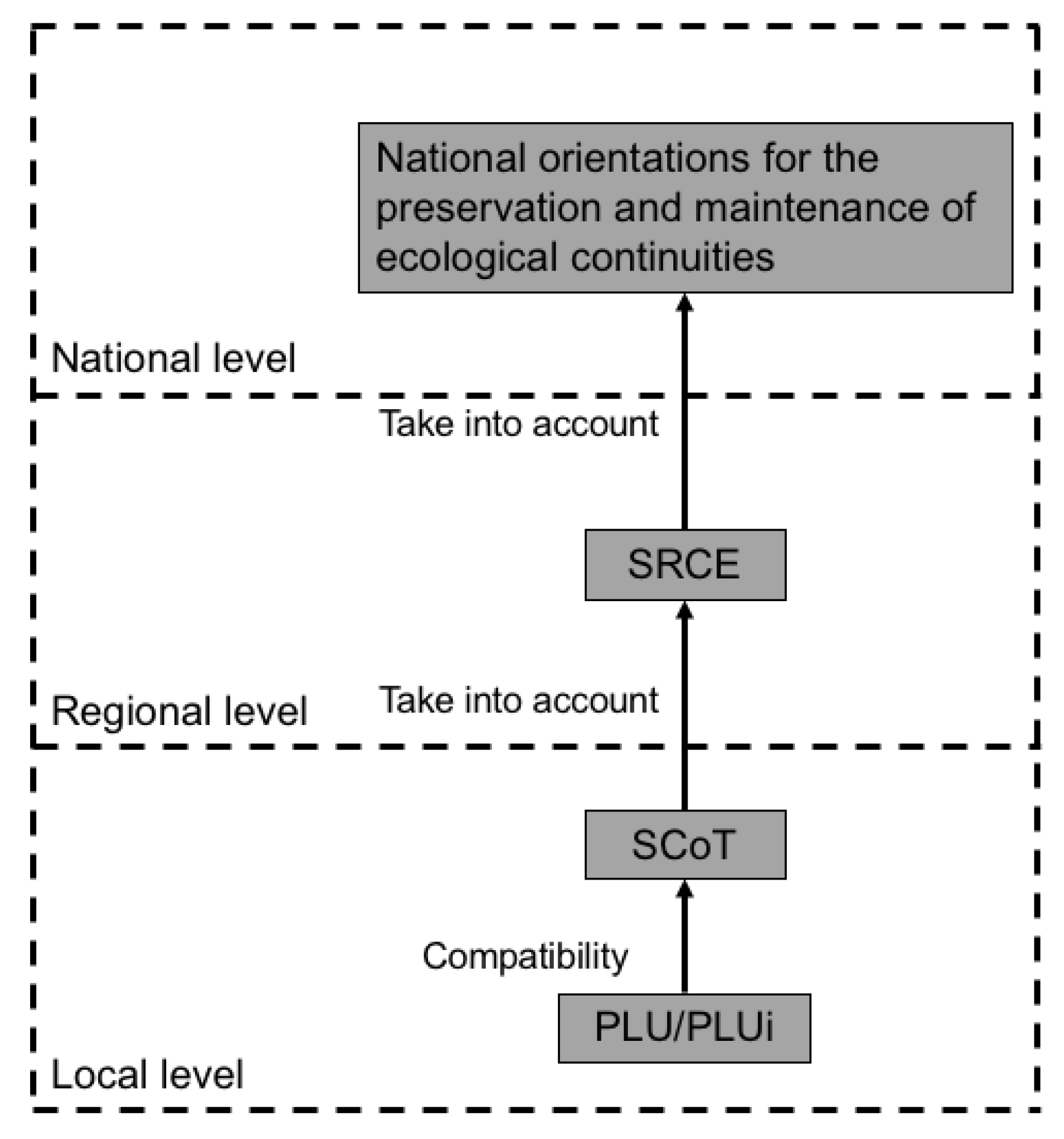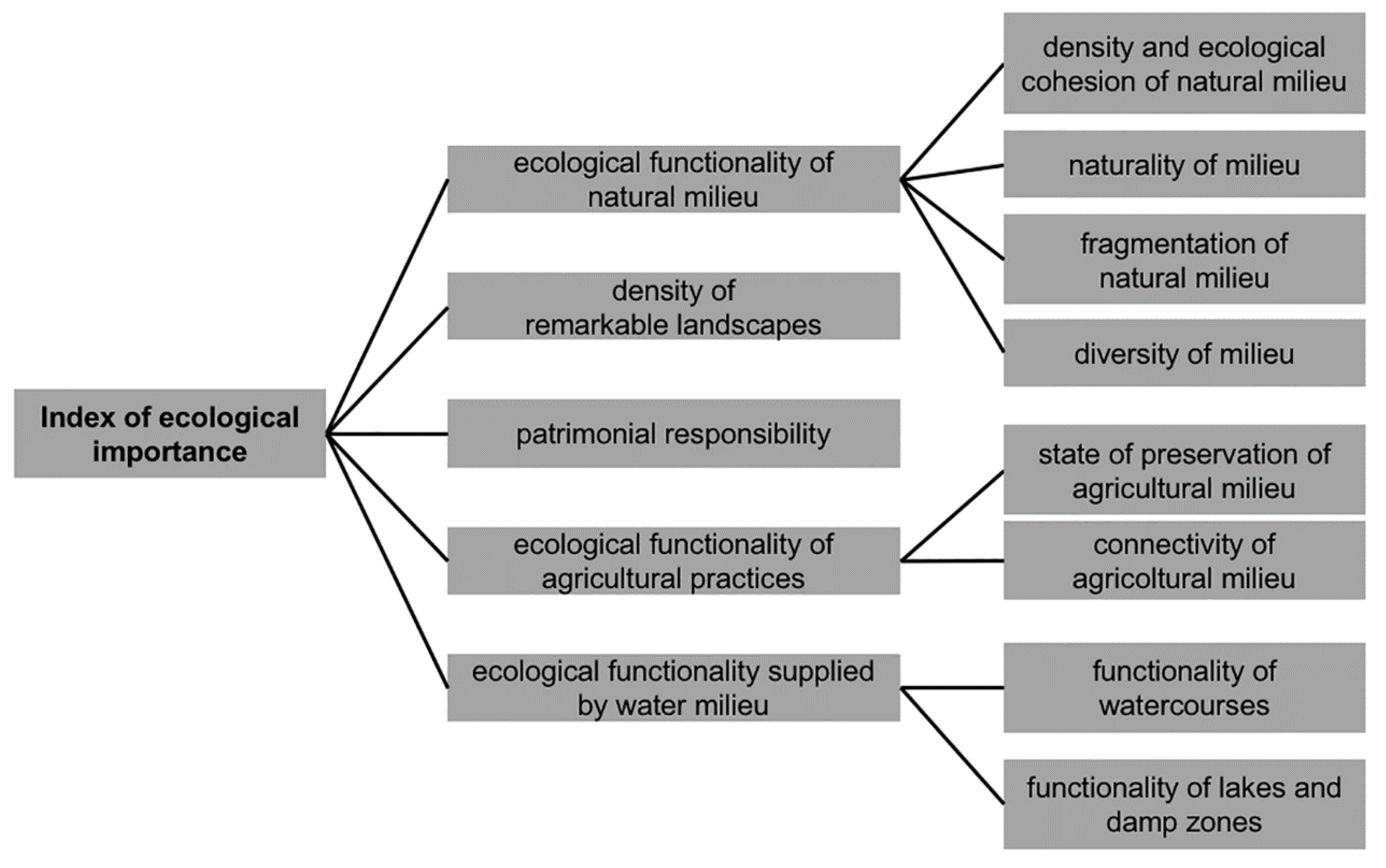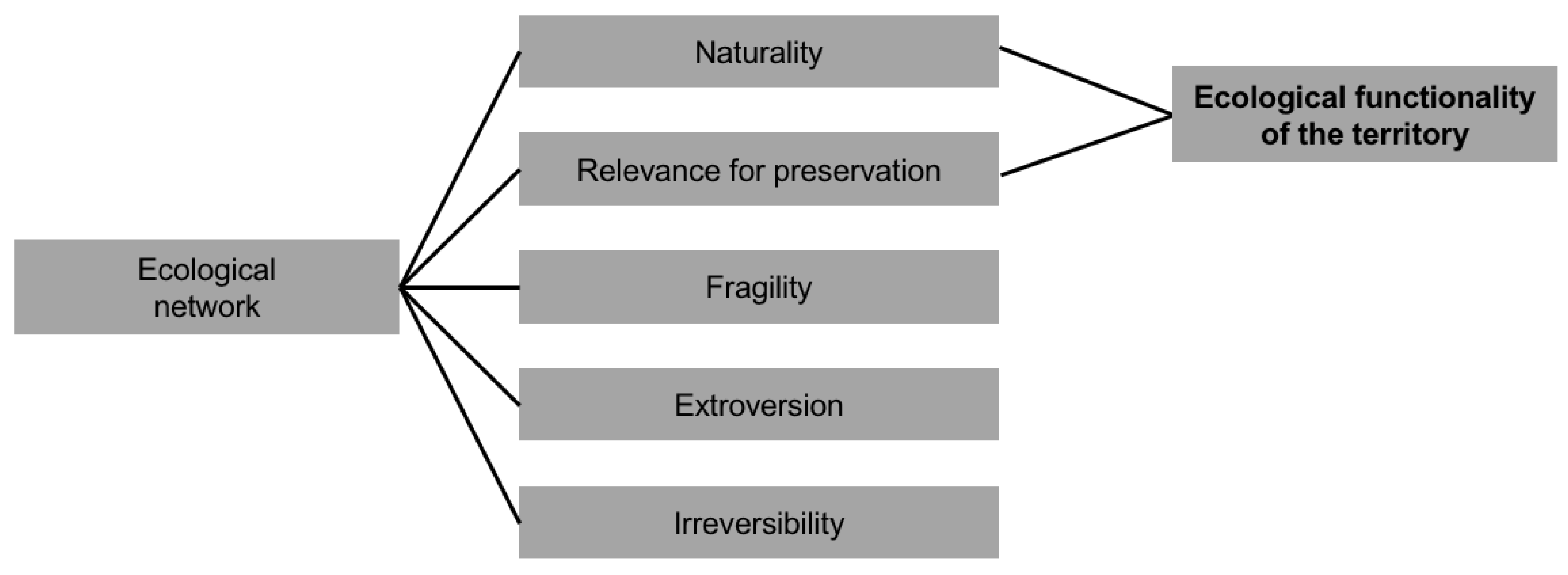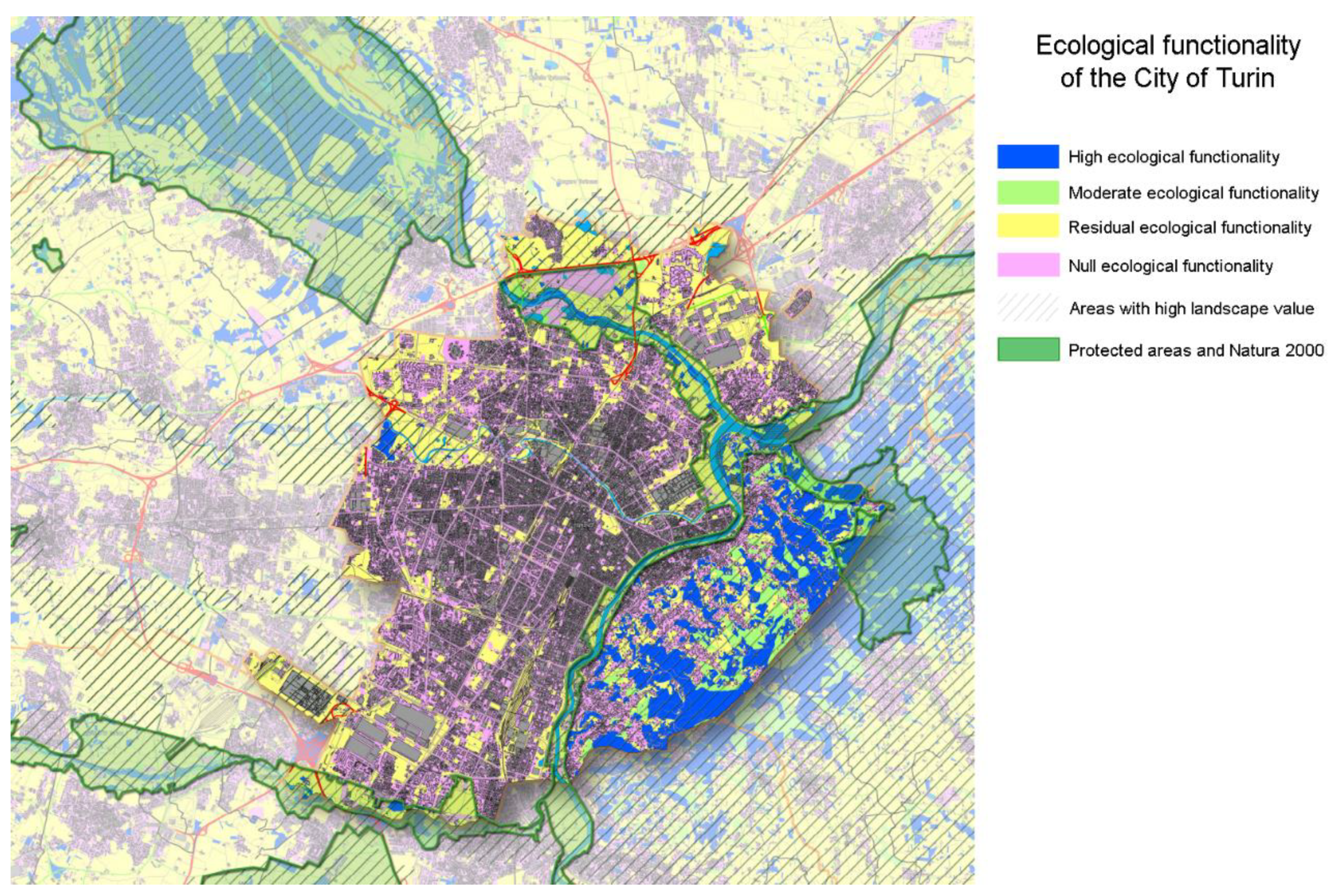Evaluating and Planning Green Infrastructure: A Strategic Perspective for Sustainability and Resilience
Abstract
1. Introduction
2. Materials and Methods
3. Sustainability and Resilience in Planning Debates
4. Green (and Blue) Infrastructure in Sustainability and Resilience Discourses
5. Two Case Studies in Comparison
5.1. French ‘Trames Vertes et Bleues’
The Region of Languedoc-Roussillon, an Example of Ecological Functionality
- the density of the natural milieu and its ecological cohesion with ZNIEFF of type 2 (considered to be a milieu of high ecological integrity);
- the naturality of the milieu, translating the level of human interventions or artificialization of a determined milieu. A low weighting is given to this indicator in the calculus of the indicator of the “integrity of natural milieu” in order to avoid an overestimation of the socio-economic factors related to the human footprint (it is strictly connected to factors used in the evaluation of the indicator of human footprint);
- fragmentation of a natural milieu;
- diversity of the milieu measures the spatial subdivision (including elevation) of different milieus which are present in a single pattern.
- population density, based on number of inhabitants in each municipality;
- population growth in each municipality;
- accommodation capacity of each pattern.
5.2. The Italian Framework of Landscape and Ecological Networks
Ecological Networks in the Metropolitan City of Turin
6. Discussion
7. Conclusions
Author Contributions
Funding
Conflicts of Interest
References
- Folke, C. Resilience (Republished). Ecol. Soc. 2016, 21, 44. [Google Scholar] [CrossRef]
- Xu, L.; Marinova, D.; Guo, X. Resilience thinking: A renewed system approach for sustainability science. Sustain. Sci. 2015, 10, 123–138. [Google Scholar] [CrossRef]
- Meerow, S.; Newell, J.P. Spatial planning for multifunctional green infrastructure: Growing resilience in Detroit. Landsc. Urban Plan. 2017, 159, 62–75. [Google Scholar] [CrossRef]
- Fiksel, J. Sustainability and resilience: Toward a systems approach. Sustain. Sci. Pract. Policy 2006, 2, 14–21. [Google Scholar] [CrossRef]
- Redman, C.L. Should sustainability and resilience be combined or remain distinct pursuits? Ecol. Soc. 2014, 19, 37. [Google Scholar] [CrossRef]
- Brand, F.S.; Jax, K. Focusing the meaning(s) of resilience: Resilience as a descriptive concept and a boundary object. Ecol. Soc. 2007, 12, 23. [Google Scholar] [CrossRef]
- Meerow, S.; Newell, J.; Stults, M. Defining urban resilience. Landsc. Urban Plan. 2016, 147, 38–49. [Google Scholar] [CrossRef]
- Derissen, S.; Quaas, M.F.; Baumgärtner, S. The relationship between resilience and sustainability of ecological-economic systems. Ecol. Econ. 2011, 70, 1121–1128. [Google Scholar] [CrossRef]
- Folke, C. Social–ecological systems and adaptive governance of the commons. Ecol. Res. 2007, 22, 14–15. [Google Scholar] [CrossRef]
- Folke, C. Resilience: The emergence of a perspective for social–ecological systems analyses. Glob. Environ. Chang. 2006, 16, 253–267. [Google Scholar] [CrossRef]
- Herrero-Jáuregui, C.; Arnaiz-Schmitz, C.; Reyes, M.F.; Telesnicki, M.; Agramonte, I.; Easdale, M.H.; Schmitz, M.F.; Aguiar, M.M.; Gómez-Sal, A.; Montes, C. What do We Talk about When We Talk about Social-Ecological Systems? A Literature Review. Sustainability 2018, 10, 2950. [Google Scholar] [CrossRef]
- Berkes, F.; Folke, C. Linking Social and Ecological Systems: Management Practices and Social Mechanisms for Building Resilience; Cambridge University Press: Cambridge, UK, 1998; ISBN 9780521785624. [Google Scholar]
- Folke, C.; Biggs, R.; Norström, A.V.; Reyers, B.; Rockström, J. Social-ecological resilience and biosphere-based sustainability science. Ecol. Soc. 2016, 21, 41. [Google Scholar] [CrossRef]
- Rusche, K.; Reimer, M.; Stichmann, R. Mapping and Assessing Green Infrastructure Connectivity in European City Regions. Sustainability 2019, 11, 1819. [Google Scholar] [CrossRef]
- Hansen, R.; Pauleit, S. From Multifunctionality to Multiple Ecosystem Services? A Conceptual Framework for Multifunctionality in Green Infrastructure Planning for Urban Areas. AMBIO 2014, 43, 516–529. [Google Scholar] [CrossRef] [PubMed]
- Kremer, P.; Hamstead, Z.A.; McPhearson, T. The value of urban ecosystem services in New York City: A spatially explicit multicriteria analysis of landscape scale valuation scenarios. Environ. Sci. Policy 2016, 62, 57–68. [Google Scholar] [CrossRef]
- Rogov, M.; Rozenblat, C. Urban Resilience Discourse Analysis: Towards a Multi-Level Approach to Cities. Sustainability 2018, 10, 4431. [Google Scholar] [CrossRef]
- Zhang, X.; Li, H. Urban resilience and urban sustainability: What we know and what do not know? Cities 2018, 72, 141–148. [Google Scholar] [CrossRef]
- Marchese, D.; Reynolds, E.; Bates, M.E.; Morgan, H.; Spierre Clark, S.; Linkov, I. Resilience and sustainability: Similarities and differences in environmental management applications. Sci. Total Environ. 2018, 613–614, 1275–1283. [Google Scholar] [CrossRef] [PubMed]
- Carpenter, S.; Walker, B.; Anderies, M.J.; Abel, N. From Metaphor to Measurement: Resilience of What to What? Ecosystems 2001, 4, 765–781. [Google Scholar] [CrossRef]
- Ahern, J. Urban landscape sustainability and resilience: The promise and challenges of integrating ecology with urban planning and design. Landsc. Ecol. 2013, 28, 1203–1212. [Google Scholar] [CrossRef]
- Scheffer, M. Critical Transitions in Nature and Society; Princeton University Press: Princeton, NJ, USA, 2009; ISBN 9780691122045. [Google Scholar]
- Holling, C.S. Resilience and stability of ecological systems. Annu. Rev. Ecol. Syst. 1973, 4, 1–23. [Google Scholar] [CrossRef]
- Delgado-Ramos, G.C.; Guibrunet, L. Assessing the ecological dimension of urban resilience and sustainability. Int. J. Urban Sustain. Dev. 2017, 9, 151–169. [Google Scholar] [CrossRef]
- Neumayer, E. Weak Versus Strong Sustainability; Edward Elgar Publishing: Northampton, MA, USA, 2003; ISBN 978-1-78100-707-5. [Google Scholar]
- World Commission on Environment and Development (WCED). Our Common Future; Oxford University Press: Oxford, UK, 1987. [Google Scholar]
- Sadler, B.; Jacobs, P. A key to tomorrow: On the relationship of environmental assessment and sustainable development. In Sustainable Development and Environmental Assessment. Perspectives on Planning for a Common Future; Jacobs, P., Sadler, B., Eds.; Canadian Environmental Assessment Research Council: Ottawa, ON, Canada, 1989; pp. 3–31. [Google Scholar]
- Healey, P.; Shaw, T. Planners, plans and sustainable development. Reg. Stud. 1993, 27, 769–776. [Google Scholar] [CrossRef]
- Campbell, S. Green cities, growing cities, just cities? Urban planning and the contradictions of sustainable development. J. Am. Plan. Assoc. 1996, 62, 296–312. [Google Scholar] [CrossRef]
- Briassoulis, H. Who Plans Whose Sustainability? Alternative Roles for Planners. J. Environ. Plan. Manag. 1999, 42, 889–902. [Google Scholar] [CrossRef]
- Olsson, P.; Galaz, V.; Boonstra, W.J. Sustainability transformations: A resilience perspective. Ecol. Soc. 2014, 19, 1. [Google Scholar] [CrossRef]
- Davoudi, S. Resilience: A bridging concept or a dead end? Plan. Theory Pract. 2012, 13, 299–307. [Google Scholar] [CrossRef]
- Voghera, A. Approaches, Tools, Methods and Experiences for Territorial and Landscape Design. In Topics and Methods for Urban and Landscape Design; Ingaramo, R., Voghera, A., Eds.; Springer: Cham, Switzerland, 2016; pp. 13–34. [Google Scholar]
- Pickett, S.T.A.; Cadenasso, M.L.; Grove, J.M. Resilient cities: Meaning, models, and metaphor for integrating the ecological, socio-economic, and planning realms. Landsc. Urban Plan. 2004, 69, 369–384. [Google Scholar] [CrossRef]
- Anderies, J.M.; Folke, C.; Walker, B.; Ostrom, E. Aligning key concepts for global change policy: Robustness, resilience, and sustainability. Ecol. Soc. 2013, 18, 8. [Google Scholar] [CrossRef]
- Adger, W.N.; Hughes, T.P.; Folke, C.; Carpenter, S.R.; Rockström, J. Social-ecological resilience to coastal disasters. Science 2005, 309, 1036–1039. [Google Scholar] [CrossRef]
- Folke, C.; Jansson, A.; Rockström, J.; Olsson, P.; Carpenter, S.R.; Chapin, F.S., III; Crépin, A.-S.; Daily, G.; Danell, K.; Ebbesson, J.; et al. Reconnecting to the biosphere. AMBIO 2011, 40, 719–738. [Google Scholar] [CrossRef] [PubMed]
- Finco, A.; Nijkamp, P. Pathway to urban sustainability. J. Environ. Policy Plan. 2001, 3, 289–309. [Google Scholar] [CrossRef]
- Levin, S. A Fragile Dominion: Complexity and the Commons; Perseus Books: Cambridge, MA, USA, 1999; ISBN 0-7382-0111-1. [Google Scholar]
- Wilkinson, C. Social-ecological resilience: Insights and issues for planning theory. Plan. Theory 2011, 11, 148–169. [Google Scholar] [CrossRef]
- De Lotto, R.; Esopi, G.; Sturla, S. Sustainable policies to improve urban ecosystem resilience. Int. J. Sustain. Dev. Plan. 2017, 12, 780–788. [Google Scholar] [CrossRef]
- Ahern, J. From fail-safe to safe-to-fail: Sustainability and resilience in the new urban world. Landsc. Urban Plan. 2011, 100, 341–343. [Google Scholar] [CrossRef]
- Newell, J.P.; Seymour, M.; Yee, T.; Renteria, J.; Longcore, T.; Wolch, J.R.; Shishkovsky, A. Green Alley Programs: Planning for a sustainable urban infrastructure? Cities 2013, 31, 144–155. [Google Scholar] [CrossRef]
- Sharifi, A. Resilient urban forms: A macro-scale analysis. Cities 2019, 85, 1–14. [Google Scholar] [CrossRef]
- Sharifi, A.; Yamagata, Y. Resilient Urban Form: A Conceptual Framework. In Resilience-Oriented Urban Planning; Yamagata, Y., Sharifi, A., Eds.; Springer: Cham, Switzerland, 2018; pp. 167–179. ISBN 978-3-319-75797-1. [Google Scholar]
- Burel, F.; Baudry, J. Écologie du Paysage. Concepts, Méthodes et Applications; Éditions TEC&DOC: Paris, France, 1999; ISBN 2-7430-0305-7. [Google Scholar]
- Clergeau, P. Une Écologie du Paysage Urbain; Éditions Apogée: Rennes, France, 2007; ISBN 9782843982880. [Google Scholar]
- Benedict, M.A.; McMahon, E.T. Green Infrastructure: Smart Conservation for the 21st Century; Sprawl Watch Clearing House: Washington, DC, USA, 2002; Available online: http://www.sprawlwatch.org/greeninfrastructure.pdf (assessed on 18 March 2019).
- Lennon, M. Green infrastructure and planning policy: A critical assessment. Local Environ. 2015, 20, 957–980. [Google Scholar] [CrossRef]
- European Commission (EC). Communication from the Commission to the European Parliament, The Council, the European Economic and Social Committee and the Committee of the Regions. Green Infrastructure (GI)—Enhancing Europe’s Natural Capital, COM (2013) 249 Final; European Commission: Brussels, Belgium, 2013. [Google Scholar]
- Lovell, S.T.; Taylor, J.R. Supplying urban ecosystem services through multifunctional green infrastructure in the United States. Landsc. Ecol. 2013, 28, 1447–1463. [Google Scholar] [CrossRef]
- Demuzere, M.; Orru, K.; Heidrich, O.; Olazabal, E.; Geneletti, D.; Orru, H.; Bhave, A.G.; Mittal, N.; Feliu, E.; Faehnle, M. Mitigating and adapting to climate change: Multi-functional and multi-scale assessment of green urban infrastructure. J. Environ. Manag. 2014, 146, 107–115. [Google Scholar] [CrossRef]
- Sussams, L.W.; Sheate, W.R.; Eales, R.P. Green infrastructure as a climate change adaptation policy intervention: Muddying the waters or clearing a path to a more secure future? J. Environ. Manag. 2015, 147, 184–193. [Google Scholar] [CrossRef]
- Boyle, C.; Babarenda Gamage, G.; Burns, B.; Fassman-Beck, E.; Knight-Lenihan, S.; Schwendenmann, L.; Thresher, W. Greening Cities. A Review of Green Infrastructure; Transforming Cities: Innovations for Sustainable Futures; University of Auckland: Auckland, New Zealand, 2014; ISBN 978-0-9922510-2-4. [Google Scholar]
- Mell, I. Global Green Infrastructure: Lessons for Successful Policy-Making, Investment and Management; Routledge: New York, NY, USA, 2016; ISBN 978-1-13-885464-2. [Google Scholar]
- Tzoulas, K.; Korpela, K.; Venn, S.; Yli-Pelkonen, V.; Kazmierczak, A.; Niemela, J.; James, P. Promoting ecosystem and human health in urban areas using Green Infrastructure: A literature review. Landsc. Urban Plan. 2007, 81, 167–178. [Google Scholar] [CrossRef]
- Artmann, M. Urban gray vs. urban green vs. soil protection—Development of a systemic solution to soil sealing management on the example of Germany. Environ. Impact Assess. 2016, 59, 27–42. [Google Scholar] [CrossRef]
- Artmann, M.; Kohlera, M.; Meinela, G.; Ganb, J.; Iojac, I.C. How smart growth and green infrastructure can mutually support each other—A conceptual framework for compact and green cities. Ecol. Indic. 2019, 96, 10–22. [Google Scholar] [CrossRef]
- Zhang, Z.; Meerow, S.; Newell, J.P.; Lindquist, M. Enhancing landscape connectivity through multifunctional green infrastructure corridor modeling and design. Urban For. Urban Green. 2019, 38, 305–317. [Google Scholar] [CrossRef]
- Nassauer, J.I.; Raskin, J. Urban vacancy and land use legacies: A frontier for urban ecological research, design, and planning. Landsc. Urban Plan. 2014, 125, 245–253. [Google Scholar] [CrossRef]
- Pallagst, K.; Fleschurz, R.; Trapp, F. Greening the shrinking city—policies and planning approaches in the USA with the example of Flint, Michigan. Landsc. Res. 2017, 42, 716–727. [Google Scholar] [CrossRef]
- van Langevelde, F.; van der Knaap, W.G.M.; Claassen, G.D.H. Comparing Connectivity in Landscape Networks. Environ. Plan. B 1998, 25, 849–863. [Google Scholar] [CrossRef]
- Voghera, A. Land Use Indicators for Landscape Assessment. In Landscape Indicators. Assessing and Monitoring Landscape Quality; Cassatella, C., Peano, A., Eds.; Springer: Dordrecht, The Netherlands, 2011; pp. 141–166. ISBN 978-94-007-0365-0. [Google Scholar]
- Schéma Régional de Cohérence Écologique (SRCE) de Languedoc-Roussillon, Enjeux Relatifs Aux espaces importants Pour la Biodiversité et Pour Les Continuités Écologiques. 2013. Available online: http://www.occitanie.developpement-durable.gouv.fr/IMG/pdf/1_SrceLrDiagV3partie1Enquete_publique_cle2f6f31.pdf (accessed on 15 April 2019).
- Ministero Dell’ambiente e Della Tutela Del Territorio e Del Mare (MATTM). Strategia Nazionale Per la Biodiversità in Italia; DPN: Roma, Italy, 2010.
- Magnaghi, A. Il Progetto Locale. Verso la Coscienza di Luogo; Bollati Boringhieri Editore: Torino, Italy, 2010; ISBN 9788833921501. [Google Scholar]
- Voghera, A.; Negrini, G.; La Riccia, L.; Guarini, S. Reti ecologiche nella pianificazione locale: Esperienze nella Regione Piemonte. Reticula 2017, 14, 1–9. [Google Scholar]
- Voghera, A.; La Riccia, L. Ecological Networks in Urban Planning: Between Theoretical Approaches and Operational Measures. In New Metropolitan Perspectives. Local Knowledge and Innovation Dynamics Towards Territory Attractiveness Through the Implementation of Horizon/E2020/Agenda2030; Calabrò, F., Della Spina, L., Bevilacqua, C., Eds.; Springer: Cham, Switzerland, 2018; Volume 2, pp. 672–680. ISBN 978-3-319-92101-3. [Google Scholar]
- Bennett, G.; Wit, P. The Development and Application of Ecological Networks. A Review of Proposals, Plans and Programmes; AID Environment: Amsterdam, The Netherlands, 2001; Available online: https://portals.iucn.org/library/sites/library/files/documents/2001-042.pdf (accessed on 20 March 2019).
- Todaro, V. Reti Ecologiche e Governo Del Territorio; FrancoAngeli: Milano, Italy, 2010; ISBN 9788856825008. [Google Scholar]
- Miller, F.; Osbahr, H.; Boyd, E.; Thomalla, F.; Bharwani, S.; Ziervogel, G.; Walker, B.; Birkmann, J.; van der Leeuw, S.; Rockström, J.; et al. Resilience and Vulnerability: Complementary or Conflicting Concepts? Ecol. Soc. 2010, 15, 11. Available online: http://www.ecologyandsociety.org/vol15/iss3/art11/ (accessed on 25 March 2019). [CrossRef]
- Folke, C.; Carpenter, S.R.; Walker, B.; Scheffer, M.; Chapin, T.; Rockström, J. Resilience thinking: Integrating resilience, adaptability and transformability. Ecol. Soc. 2010, 15, 20. Available online: http://www.ecologyandsociety.org/vol15/iss4/art20/ (accessed on 25 March 2019). [CrossRef]
- Wilker, J.; Rusche, K.; Rymsa-Fitschen, C. Improving Participation in Green Infrastructure Planning. Plan. Pract. Res. 2016, 31, 229–249. [Google Scholar] [CrossRef]
- Haase, D.; Kabisch, S.; Haase, A.; Andersson, E.; Banzhaf, E.; Baró, F.; Brenck, M.; Fischer, L.K.; Frantzeskaki, N.; Kabisch, N.; et al. Greening cities—To be socially inclusive? About the alleged paradox of society and ecology in cities. Habitat Int. 2017, 64, 41–48. [Google Scholar] [CrossRef]






| Sustainability Science Approach | Resilience Approach | |
|---|---|---|
| Peculiarities | Overarching goal for social justice, environmental protection and economic efficiency Radical reorganization of the social-ecological system | Capacity to change, adapt and transform over time with or without disturbances Overcome social-ecological limits |
| Common elements | Integrate environmental and planning management Need of a reflective capacity Need of flexibility of the process Inclusion of stakeholders Robustness Biological diversity | |
| Resilience | Sustainability | References | ||
|---|---|---|---|---|
| Governing climate change | Managing and regulating stormwater hazards | x | [21,42,52,55] | |
| Improving soil, air and water quality | x | [52] | ||
| Regulating urban heat island effect | x | x | [53,56] | |
| Limiting land take and soil sealing | x | [57,58] | ||
| Enhancing landscape quality | Supporting landscape connectivity and fruition (slow mobility) | x | [3,59] | |
| Supporting ecological functionality and accessibility to green space | x | x | [3] | |
| Recovery of degraded and vacant land | x | [59,60,61] | ||
| Promoting well-being | Reducing social and ecological vulnerability | x | x | [3] |
| Developing healthy communities | x | x | [52,56] |
| Resilience | Sustainability | |||
|---|---|---|---|---|
| French indicators | Index of ecological importance | ecological functionality of natural milieu | x | x |
| density of remarkable landscapes | x | x | ||
| patrimonial responsibility | x | |||
| ecological functionality of agricultural practices | x | x | ||
| ecological functionality supplied by water milieu | x | x | ||
| Index of human footprint | composed indicator of soil artificialization | x | x | |
| composed indicator of transport network | x | |||
| composed indicator of demographic presence | partially | x | ||
| density of energy network | x | |||
| development projects | x | |||
| Italian indicators | naturality | x | x | |
| relevance for preservation | x | x | ||
| fragility | x | x | ||
| extroversion | x | |||
| irreversibility | x |
© 2019 by the authors. Licensee MDPI, Basel, Switzerland. This article is an open access article distributed under the terms and conditions of the Creative Commons Attribution (CC BY) license (http://creativecommons.org/licenses/by/4.0/).
Share and Cite
Voghera, A.; Giudice, B. Evaluating and Planning Green Infrastructure: A Strategic Perspective for Sustainability and Resilience. Sustainability 2019, 11, 2726. https://doi.org/10.3390/su11102726
Voghera A, Giudice B. Evaluating and Planning Green Infrastructure: A Strategic Perspective for Sustainability and Resilience. Sustainability. 2019; 11(10):2726. https://doi.org/10.3390/su11102726
Chicago/Turabian StyleVoghera, Angioletta, and Benedetta Giudice. 2019. "Evaluating and Planning Green Infrastructure: A Strategic Perspective for Sustainability and Resilience" Sustainability 11, no. 10: 2726. https://doi.org/10.3390/su11102726
APA StyleVoghera, A., & Giudice, B. (2019). Evaluating and Planning Green Infrastructure: A Strategic Perspective for Sustainability and Resilience. Sustainability, 11(10), 2726. https://doi.org/10.3390/su11102726






